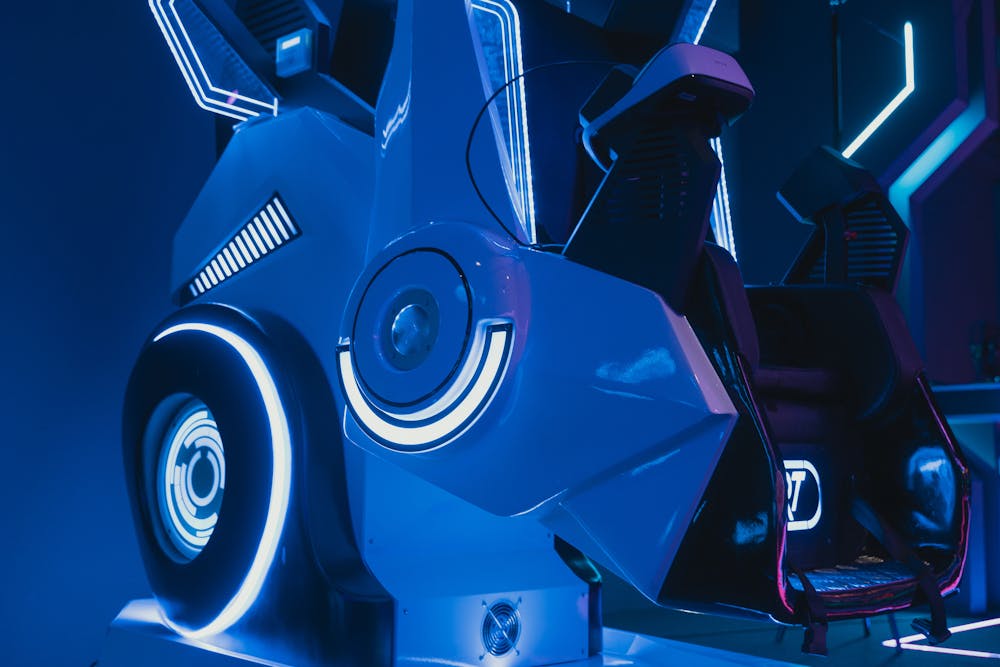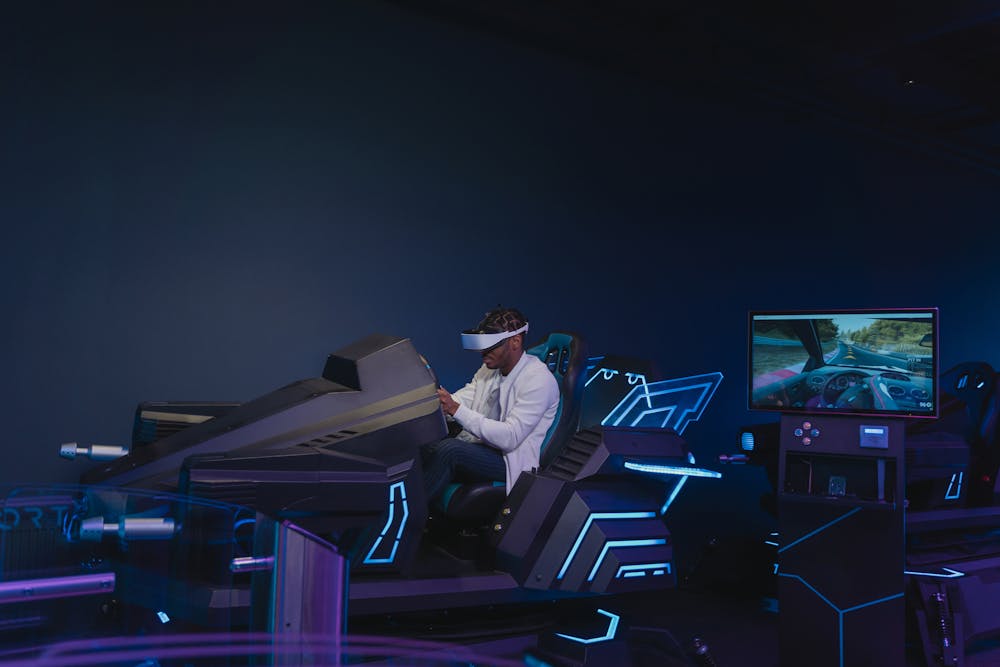How VR Simulators Can Maximize Returns for Your Arcade Business
- Introduction
- Key Benefits of Adding VR Simulators to Your Arcade Business
- Enhanced Immersion and Customer Engagement
- High Replay Value and Variety
- Premium Pricing Opportunities
- Social Media Visibility and Word-of-Mouth
- Cost vs. ROI: Evaluating Investment
- Initial Investment
- Revenue Projections
- ROI Timeline
- Secondary Revenue Streams
- Maintenance and Operational Support
- Hardware Maintenance
- Software Updates
- Staff Training
- Customer Flow Management
- FAQ
- Conclusion
Introduction
The arcade industry has evolved from simple coin-operated machines to state-of-the-art, immersive attractions. Nowadays, arcades are about more than just nostalgia; they offer experiences that customers cannot replicate at home. One of the many innovations that has become a cornerstone for modern arcade businesses is the VR shooting simulator.
Unlike traditional shooters, which rely on screens and joysticks, VR technology transports players directly into the game environment. Players feel as though they are holding real weapons, dodging incoming attacks and working as part of a squad. It is this sense of immersion that sets VR apart, explaining why it is one of the fastest-growing investments in arcade entertainment.
In this article, we will explore the benefits, applications, costs, potential return on investment (ROI), maintenance requirements and frequently asked questions about VR simulators. By the end, you will understand why VR is an effective revenue generator and how to integrate it strategically into your arcade.

Key Benefits of Adding VR Simulators to Your Arcade Business
All arcade operators want attractions that are profitable, engaging and easy to manage. VR simulators, especially VR shooting simulators, tick all these boxes. Before we look at the financials and logistics, let’s consider the most significant benefits.
Enhanced Immersion and Customer Engagement
A VR shooting simulator offers an unparalleled level of realism compared to traditional arcade cabinets. High-resolution headsets and motion-tracked controllers make players feel as if they are in the middle of intense combat. For instance, a zombie-themed VR shooting game puts players in a life-or-death situation in which they must aim, reload and survive under pressure. This level of engagement encourages repeat visits and longer play sessions.
High Replay Value and Variety
Shooting games have always been one of the most popular genres in arcades. With VR, the replay value increases. Arcades can offer a variety of VR shooting games, ranging from futuristic sci-fi battles to military missions and even Wild West duels. By regularly updating the scenarios, customers are encouraged to return and face new challenges.
Premium Pricing Opportunities
One of the biggest advantages of offering VR experiences is the flexibility of the pricing model. A 5-minute VR shooting simulator experience can cost between $5 and $15, depending on the market. Compared to traditional arcade machines, which may charge $1–$2 per play, VR generates significantly higher revenue per customer.
Social Media Visibility and Word-of-Mouth
VR experiences are inherently shareable. Players often record themselves playing, post reactions on TikTok or Instagram, and spread excitement through word-of-mouth. This creates free marketing for your arcade, expanding your reach without additional advertising costs.
Key applications of VR simulators
To maximize the profitability of your arcade, it is essential to understand the various uses of VR shooting simulators. They aren’t just for casual entertainment; they can serve multiple purposes.
Core Arcade Entertainment
For many businesses, VR shooting becomes the centerpiece attraction. The most popular VR shooting simulator setups feature realistic rifles with recoil, haptic feedback and multiplayer capabilities. By positioning the simulator in a visible, high-traffic area, arcades can attract curious customers and encourage them to become regular players.
Competitive tournaments and esports
Competition drives engagement. Hosting VR shooting tournaments with leaderboards or weekly challenges can help to build a loyal player base. Customers who might otherwise only visit occasionally start to return regularly in order to improve their scores. This transforms VR from a novelty into a community-building tool.
Group events and team-building
Corporate groups and birthday parties can be a valuable source of revenue for arcades. VR shooting simulators provide a unique group activity in which players can either work together against the AI or battle each other in multiplayer matches. This establishes your arcade as a destination for both fun and team-building experiences.
Training applications
While the main focus of arcades is entertainment, it’s worth noting that VR shooting simulators also have serious training applications. The law enforcement, military and security industries use VR to train recruits in weapon handling and situational awareness. For arcades, promoting the realism and skill-building aspects of VR can enhance its perceived value.

Cost vs. ROI: Evaluating Investment
Now that we’ve covered the benefits and applications, the next logical question is whether the investment is worthwhile. To answer this, let’s examine the costs and potential returns of owning a VR shooting simulator.
Initial Investment
The vr shooting simulator price depends on scale and features:
- Entry-level setups: $5,000–$15,000, usually single-station units with basic interactivity.
- Mid-range systems: $20,000–$50,000, offering multiple scenarios, haptic guns, and multiplayer options.
- Premium attractions: $50,000–$100,000+, often featuring custom-built arenas, high-end haptics, and large player capacity.
Revenue Projections
Let's assume that a five-minute session costs $10. If a single station runs six sessions per hour for eight hours per day, it could generate $480 per day—or almost $14,000 per month. Multiply that by the number of stations in operation, and it's easy to see why VR is considered by operators to be one of the most profitable attractions.
ROI Timeline
Most arcade operators report achieving ROI within 6–12 months. Compare this to bowling alleys or bumper car setups that may take years to pay off due to larger space and maintenance requirements. This quick ROI is what makes VR particularly attractive for small and medium arcades.
Secondary Revenue Streams
VR opens the door to additional income opportunities. You can sell branded merchandise, offer loyalty memberships, or run exclusive VR events. These secondary streams extend the profitability of your investment.
Maintenance and Operational Support
A common concern is whether high-tech attractions require constant maintenance. The good news is that VR shooting simulators are usually easier to maintain than traditional arcade machines.
Hardware Maintenance
VR headsets, sensors, and controllers require daily cleaning and occasional calibration. Using sanitizing stations not only protects the equipment but also reassures customers about hygiene. Replacing worn-out cables or padding is inexpensive compared to repairing mechanical rides.
Software Updates
The ability to refresh content is one of the greatest strengths of VR. Rather than replacing the entire machine, operators can simply purchase or download new VR shooting games. This ensures the attraction remains exciting while minimizing hardware costs.
Staff Training
Your employees don’t need to be VR experts, but proper training is essential. Staff should know how to guide first-time players, explain controls, and handle technical resets. Good customer service can turn a confused newcomer into a loyal returning player.
Customer Flow Management
Since VR sessions typically last several minutes, arcades must plan for customer flow. Clearly marked waiting areas, screens showing gameplay footage, and signage with session pricing all contribute to smoother operations and higher throughput.

FAQ
Question 1: How durable are VR simulators in a busy arcade?
Commercial-grade VR simulators are designed to withstand heavy use. With proper cleaning and regular firmware updates, they can last for years with minimal downtime.
Q2: What is the average price of a VR shooting simulator?
Prices vary widely: entry-level systems may cost around $10,000, while premium multiplayer platforms can exceed $80,000 depending on the features included.
Q3: Which is the best VR shooting simulator for arcades?
The best VR shooting simulator depends on your available space, budget and target audience. Smaller arcades may prefer compact single stations, while larger centres can invest in full-scale multiplayer arenas with advanced haptic feedback.
Q4: Do VR simulators need a lot of space?
Not necessarily. Many systems are modular and can be installed in spaces as small as 3–5 square metres. Larger setups can be scaled up for arenas or competitive formats.
Q5: Are VR shooting simulators only for younger audiences?
While teenagers and young adults are the main demographic, adults in their 30s and 40s also enjoy the realism of VR. The combination of arcade nostalgia and modern immersion makes VR appealing to people of all ages.
Conclusion
The rise of VR is transforming the arcade industry. By offering VR shooting simulators, business owners can provide an immersive entertainment experience, charge higher prices and achieve a faster return on investment than with many other attractions.
For arcades seeking long-term success, VR is more than just an add-on — it’s a growth strategy. With careful planning, staff training and regular content updates, the best VR shooting simulator can become the highlight of your arcade.
👉 To discover advanced solutions and bespoke systems, consider VRN0.1, a trusted provider of VR arcade equipment that helps businesses maximise profitability while delivering unforgettable customer experiences.




Products
Can I customize the VR experience for my business?
Yes, we offer tailored VR experiences to suit your business needs, from custom content to specific hardware configurations, ensuring the best possible experience for your customers.
Application
How much space does VRNO.1's VR equipment require?
Our VR equipment is designed to adapt to family entertainment centers of different sizes. For smaller spaces, we have compact solutions for interactive games for one or two people. For larger venues, we provide multi-user interactive experience solutions that can support multiple people to experience at the same time.
Does the device support wireless use?
Some VRNO.1 VR devices support wireless connection, which makes it easier to move freely in different spaces without worrying about cable restrictions, enhancing the immersion and freedom of the game.
Home
How does VRNO.1’s VR technology work?
Our VR systems use advanced headsets, motion tracking, and interactive controls to create an immersive, 360-degree experience. Players can engage with digital environments in real time, simulating real-world and fantastical scenarios.
Solution
How to customize VR equipment and content for my venue?
VRNO.1 provides personalized customization services. You can choose different VR equipment and game content according to the type of venue, customer group and budget requirements. Our design team will communicate with you to ensure the best solution and design the venue layout.

Experience our VR Shooting Simulator—an unattended arcade game with coin/card payment support, offering an immersive, hassle-free shooting experience for all players.

Experience the thrill of aerial combat with VRN0.1's VR Warplanes Realistic Air Combat Simulation. Our Shocked Sway Flying Combat VR Simulator immerses you in intense dogfights, delivering unparalleled realism. Perfect for flight enthusiasts, this Flying Combat VR Simulator promises an adrenaline-pumping adventure.


Want to know more updates?
If you have any technical questions or after-sales needs, please feel free to contact our service team.
We will wholeheartedly provide you with quick response and professional support to ensure the smooth operation of your VR & Arcade project.



 Scan QR Code
Scan QR Code
Whatsapp: +8618127818571
Scan QR Code
Guangzhou Skyfun Technology Co.,Ltd
skyfunvrgame
skyfun game